
The "V bombers" were the Royal Air Force (RAF) aircraft during the 1950s and 1960s that comprised the United Kingdom's strategic nuclear strike force known officially as the V force or Bomber Command Main Force. The three models of strategic bomber, known collectively as the V class, were the Vickers Valiant, which first flew in 1951 and entered service in 1955; the Avro Vulcan, which first flew in 1952 and entered service in 1956; and the Handley Page Victor, which first flew in 1952 and entered service in 1957. The V Bomber force reached its peak in June 1964 with 50 Valiants, 70 Vulcans and 39 Victors in service.

The Handley Page Halifax is a British Royal Air Force (RAF) four-engined heavy bomber of the Second World War. It was developed by Handley Page to the same specification as the contemporary twin-engine Avro Manchester.

Number 99 Squadron is a squadron of the Royal Air Force which operates the Boeing C-17 Globemaster III strategic/tactical transport aircraft from RAF Brize Norton.
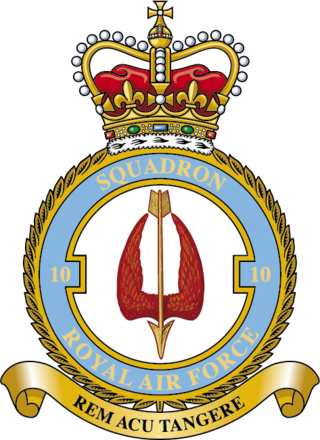
Number 10 Squadron is a Royal Air Force squadron. The squadron has served in a variety of roles over its 90-year history. It currently flies the Airbus Voyager KC2/KC3 in the transport/tanker role from RAF Brize Norton, Oxfordshire.

No. 460 Squadron is a Royal Australian Air Force intelligence unit active within the Defence Imagery and Geospatial Organisation (DIGO). It was first formed as a heavy bomber squadron during World War II on 15 November 1941 and disbanded on 10 October 1945 after seeing extensive combat over Europe. The squadron was a multinational unit, but most personnel were Australian. No. 460 Squadron was reformed on 2 July 2010 and is currently located in Canberra.

No. 27 Squadron of the Royal Air Force operates the Boeing Chinook from RAF Odiham.
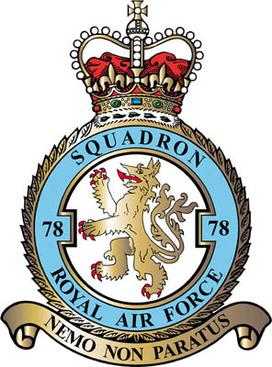
No. 78 Squadron of the Royal Air Force, is the squadron number plate of RAF (Unit) Swanwick based at London Area Control Centre, Swanwick, Hampshire. The squadron was allocated the role in early 2021.

No. 202 Squadron of the Royal Air Force is the maritime and mountains training element of the No.1 Flying Training School, operating the Airbus Helicopters H145 Jupiter.
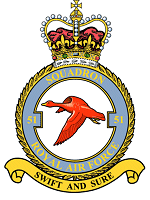
Number 51 Squadron is a squadron of the Royal Air Force. Since 2014 it has operated the Boeing RC-135W Airseeker R.1, more commonly referred to as the Rivet Joint, from RAF Waddington, Lincolnshire.

No. 543 Squadron RAF was a photographic reconnaissance squadron of the Royal Air Force, active in two periods between 1942 and 1974.
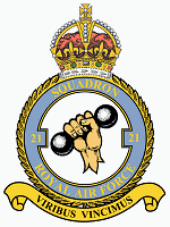
No. 21 Squadron of the Royal Air Force was formed in 1915 and was disbanded for the last time in 1979.

No. 35 Squadron was a squadron of the Royal Air Force.
No. 462 Squadron is a Royal Australian Air Force (RAAF) squadron which forms part of the Information Warfare Directorate in the RAAF's Air Warfare Centre. The squadron was first formed in 1942 as a heavy bomber unit and saw combat in this role in the Mediterranean area until it was disbanded in March 1944. It was reformed in the United Kingdom in August 1944 to participate in the bombing campaign against Germany, and in December that year converted to a specialist electronic warfare unit. No. 462 Squadron continued in this role until the end of the European war in May 1945 and was disbanded in September that year. The squadron was reformed in its current role during April 2005.
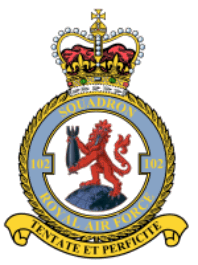
No. 102 Squadron was a Royal Air Force night bomber squadron in the First World War and a heavy bomber squadron in the Second World War. After the war it flew briefly as a transport squadron before being reformed a light bomber unit with the Second Tactical Air Force within RAF Germany. Its last existence was as a Thor strategic missile unit.

Number 207 Squadron is a historic bomber squadron and, latterly, a communications and flying training squadron of the Royal Air Force. It was announced on 5 July 2017 that No. 207 Squadron will again reform to become the Operational Conversion Unit for the UK F-35B Lightning Force and will return to RAF Marham in Norfolk where it was last based in 1965. No. 207 Squadron arrived at RAF Marham with six F-35Bs on 16 July 2019 before officially standing up on 1 August.

No. 518 Squadron RAF was a meteorological squadron of the Royal Air Force during the Second World War. The weather observations they collected helped inform Group Captain James Martin Stagg's recommendation to General Dwight D. Eisenhower to delay the launching of the D-Day invasion of Normandy from 5 June to 6 June 1944.

No. 502 (Ulster) Squadron was a Royal Auxiliary Air Force squadron that saw service in World War II. It was reformed in September 2013, and is the oldest of all the reserve squadrons, being formed in 1925.
Number 58 Squadron was a squadron of the Royal Air Force.

No. 103 Squadron was a Royal Air Force bomber squadron during World War I, World War II and the Cold War, switching to helicopters in the late 1950s until it was disbanded for the last time in 1975.
No. 137 Squadron RAF existed briefly as a day bomber unit in World War I but never became operational. During World War II it flew as one of the two Whirlwind squadrons before converting to Hurricane Mk.IV fighter-bombers and later the Hawker Typhoon in the same role. The squadron was disbanded in August 1945.

















